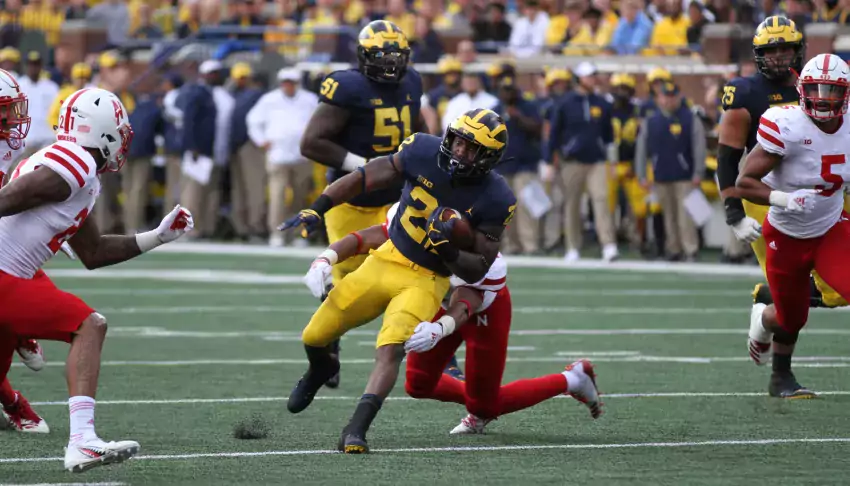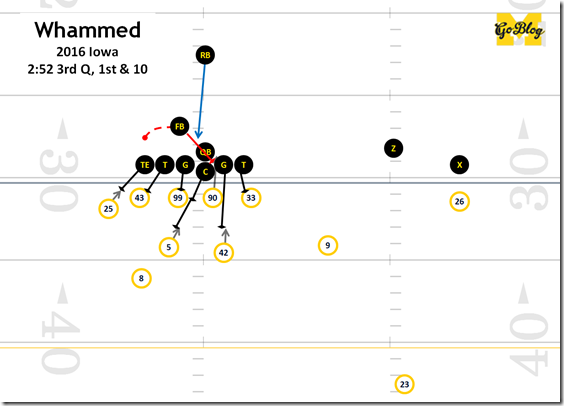wham block

Nebraska fixed their atrocious linebackers by giving them aggressive reads. So Michigan unfixed them. [photo: Eric Upchurch]
I had a very hard time pulling anything interesting from this game. I wanted to see Michigan dominating with skill, speed, and play design, but the takeaway after a rewatch was Nebraska's linebackers were responsible for much of the Michigan offense's explosive day.
This was something of a surprise. In the film preview I thought the Huskers had found a good player in WLB Mohamed Barry (#7) and a serviceable one in MLB Dedrick Young (#5) by giving them easy Keys and telling them to play those aggressively. I think Michigan saw this too, and also a way to use that to make Nebraska's linebackers atrocious again.
So the play in question is the first snap of Michigan's second drive. They had already used it for a big Higdon run on the first drive but Nebraska did some funny stuff that time while this was straight-up pwnage.
Michigan is running two concepts on this play to screw with the Nebraska LBs' Keys. On the frontside it's Down G, and on the backside it's a Wham Block. Let's go over the bolded terms.
About Keys
One of the great things about about Down G is how it messes with "Keys." Keys are cheats that defenses use to get extra defenders to the ball faster by identifying what the play is by certain types of backfield action. Every defense uses keys, and the game that running game coordinators are often playing is identifying what the defense's keys are then using that against them. The defense meanwhile will have different keys for different looks to punish an offense that just sticks to the plays they run well.
A highly common Key against power teams is to read your guard. The backside LB ("W" in the diagrams below) is often Keying the backside guard to decide what to do. If the guard pulls, that LB can guess the ball's going that way too and hightail it across the formation, arriving in the intended gap before the pulling guard and mucking everything up.
If that backside LB reads a zone block he doesn't activate so quickly, since he's got to cover that lane in case of a cutback. For completeness if the guard steps back to pass block, the LB knows to sink into coverage, or if the guard releases the LB knows to get playside and dodge the block.
Keying is a slider; you can use it as information while staying on your assignments, or tell your players to go hell for leather whenever they read one. Where you set that has to do with what your players are capable of doing on their own. If you have a particularly fast linebacker or one who can diagnose more things on his own, you don't have to try to cheat him into the right spot so much. Think back to 2011 Michigan with Brandin Hawthorne, who could knife through for some key stops or get caught paralyzed, versus Desmond Morgan, who though a true freshman was more diagnostic and decisive in his approach.
Nebraska is at the Hawthorne stage of a similarly wholesale rebuild. They're not as blitzball as the WMU and SMU linebackers when they Key run action, but they're up there with recent Rutgers and Minnesota teams Michigan's faced who don't wait to see the whites of their blockers' eyes before firing at a gap. As you may have derived from those memories, playing blitzball against a Harbaugh run game can get you a few stuffs followed by a good view of the back of Higdon's jersey. Except with the Huskers, it was a different shiny thing.
[After THE JUMP: Michigan's getting good at this, Nebraska was REALLY bad]
I found this incredibly annoying this weekend:
Michigan has 8 1/2 in the box, and yet Iowa is able to get 8 yards on 1st down. Even more galling is they did it with a nifty trick that hadn’t been seen much of in the Big Ten until Harbaugh brought it back last year. It’s the wham. And it had no right to go this well.
Wham Defined
A wham is a first level block by the fullback or TE, freeing up an offensive lineman to release to the next level. It’s a type of Trap, which is a when you leave an interior defensive lineman unblocked before hitting him from another angle. But when you think of a “trap” it’s usually pulling an offensive lineman to blindside the DL you left unblocked to roar into the backfield.
A wham is less about catching the defense overreacting and more about winning a one-on-one matchup they didn’t expect, in this case between a fullback or H-back and an interior DL. The block is a kick-down, and happens within a second of the snap. If executed, you’ve erased the defense’s most important run defender with your fullback’s block, and your center (who’s often your best run blocker) gets a free release into the linebackers.
Wham block in red
Often a wham block starts with that fullback or tight end in motion. This keeps him out of view of the DT he’ll end up blocking until it’s almost too late, and can give him more of a head start, since the fullback is bound to be giving up some weight on the DT, and will have to make up for it with momentum.
BlueGraySky put together a great video compilation of Notre Dame’s wham blocks from a decade ago:
If you’re mad about watching Domers, know that Michigan’s ‘06 defense appears twice and does a pretty good job against it.
[After the JUMP: What they win, what they risk, and how it goes]


53